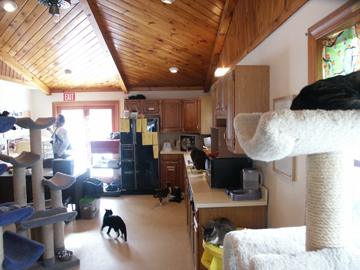 Merrimack River Feline Rescue Society Collaboration Project Report  Download PDF version Download PDF version
Report by Lilly Donohue Project Team: Daniel Adams, Lilly Donohue, Katice Helinski, Oliver Lutz, Naveem Mowlah, Nomita Sawhney |
 Merrimack River Feline Rescue Society Collaboration Project Report  Download PDF version Download PDF version
Report by Lilly Donohue Project Team: Daniel Adams, Lilly Donohue, Katice Helinski, Oliver Lutz, Naveem Mowlah, Nomita Sawhney |
|
Goals There were two primary objectives to this project; to engage with a specific community, and to mass produce objects that could interact with this community and that could be distributed within its existing infrastructure. We also needed to consider organizing an exhibition in which these objects, along with the chronicling of our relationship and understanding of this organization could be displayed. Choosing a Community Our group decided that the most effective method to address this project would be to begin with finding the community that we would be working with in order to examine the ways in which they operated and where we might be most successful in providing an object for them. We looked into a variety of local organizations, searching for one that had a substantial existing network in which we could operate as well as a focus that would provide a compelling topic for our investigation. Ultimately, we decided to work with the Merrimack River Feline Rescue Society. This organization was of interest to us for a variety of reasons, in particular the substantial number of interrelated programs in which we could intervene. Among these programs is a feral cat feeding and trapping initiative which was of particular interest. We were intrigued by the notion of exploring the relationship between these people and feral cats. These animals are very explicitly not domesticated pets, yet volunteers invest a tremendous amount of time and effort to alter the lives of these "wild" animals. As a result, these feral cats reside somewhere on the precipice of autonomy and reliance on the desire of humans to assign some level of domesticity to their existence. Research After some preliminary research and telephone communication, we made the decision to go up to Salisbury, MA to the headquarters of the Feline Rescue Society to meet with a representative of the organization. We decided to document the entire process, through photography, video, and mapping in order to represent our interaction with this community, an aspect of our project that we determined was crucial. During this meeting, we learned of the existence a large number of feral cat colonies in the general area. Each of these colonies has been given a feeding station where volunteers distribute food to the cats. Approximately thirty-five volunteers are responsible for feeding these colonies twice daily. |
|
|
next >> |